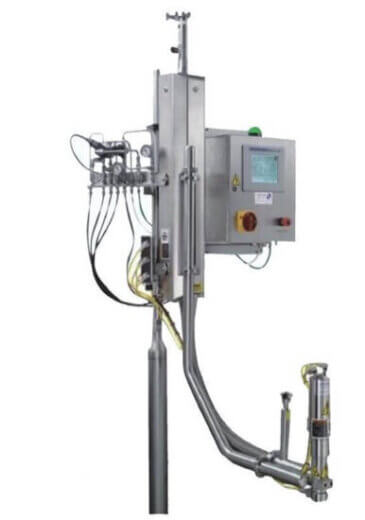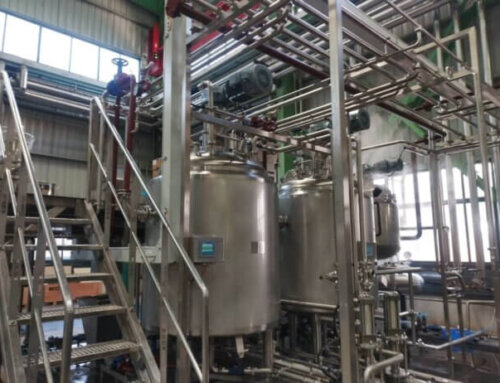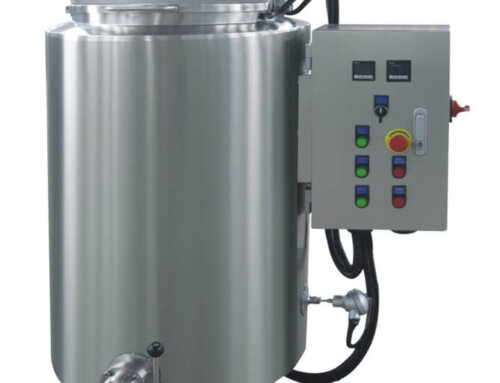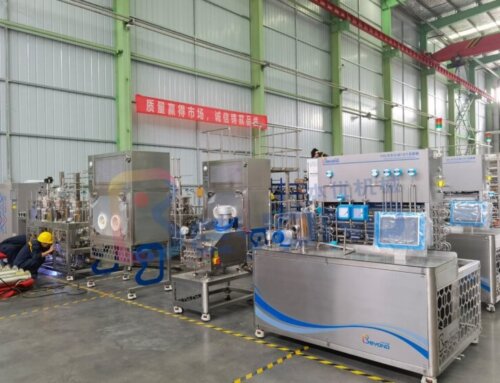Mayonnaise Production Line Description
Mayonnaise is a thick and semi-solid seasoning sauce made mainly of vegetable oil, eggs, lemon juice or vinegar, and other seasonings with a viscosity of about 2000-3000cP at 20℃. It is generally used in salads and other dishes. In the general case, only the yolk is used for the egg, but there is also the practice of using whole egg liquids.
The mayonnaise is light yellow, moderately soft, viscous, with a certain degree of toughness, refreshing fragrance and strong aftertaste. The phospholipids in the egg yolk have a strong emulsification effect, so it can form a stable emulsion. The oil is dispersed in the vinegar in the form of fine particles of 2-4 microns. When eating, the water phase first comes into contact with the tongue, so it first gives people a smooth and refreshing sour taste, and then the oil phase can be detected. The unopened mayonnaise package shelf life is about one week stored at dry cool area after the date on the package. But after you opened the package, you need to store in the refrigerator and the shelf life is one month.
Traditional mayonnaise is an oil-in-water emulsion cold sauce that contains 65-80% vegetable oil, 5-8% egg yolk and a spiced water phase. The latter typically includes vinegar, mustard, salt and sugar. The oil is present as dispersed droplets with an average size ranging from 2 – 10 microns.
Mayonnaise was invented by the French and has been selling well in Europe, America and other countries since the 1950s. According to European and American identification standards, mayonnaise is classified as an emulsified semi-solid food. The main raw materials for its production are vegetable oil, egg yolk, vinegar and salt. These four ingredients are necessities and cannot be made without one. Other non-essential raw materials are sugar, MSG, mustard, starch, white pepper and other spices. The amount of oil in the mayonnaise usually will be no less than 65%, and generally 77%-82% is better.
Commercial mayonnaise production involves mixing oil, egg yolks, vinegar or lemon juice, salt, and spices in a vacuum mixing vessel, homogenizing the mixture, pasteurizing it to increase shelf life, cooling it, packaging it, conducting quality control checks, and distributing it to retailers or food service establishments.

Mayonnaise Production Line End Products
The Mayonnaise after blending and homogenizing, can be filled into metal cans, glass bottles, flexible pouches, sachets, or aseptic bag in box containers, and it can be divided into the following types:
Full-fat mayonnaise: This type of mayonnaise is also called traditional mayonnaise. It is made primarily from egg yolks(6%-10%), oil(65%-80% fat), vinegar or lemon juice, and seasonings.
Low-Fat Mayonnaise: Contains less oil (50% fat), egg yolk(3%-4%), and fewer calories than traditional mayonnaise. It may use substitutes like yogurt or sour cream. In low-fat recipes, the role of egg yolk-based lecithin can be fully covered by starch, eventually starch and gum (xanthan gum).
Vegan Mayonnaise: It refers to the egg yolk in mayonnaise being replaced by plant-based products such as soy and sunflower lecithin when processing. Egg yolk also contributes to the taste and color of mayonnaise. However, this can fairly easily be arranged by the use of plant-based flavors and colorants.

Mayonnaise Processing Recipe
There are two typical recipes for mayonnaise production: 80% oil mayonnaise and low fat mayonnaise, and the ratio of the each ingredients please check the below:
| Ingredients | 80% Oil Formula | Low Fat Formula |
|---|---|---|
| Vegetable Oil | 80% | 50% |
| Egg Yolk | 6% | 4% |
| Other Thickness | NA | 4% |
| Vinegar | 4% | 3% |
| Sugar | 1% | 1.5% |
| Salt | 1% | 0.7% |
| Spices | 0.5% | 1.5% |
| Water | 7.5% | 35.3% |
Key Points Of Mayonnaise Production Line
–Mayonnaise production needs to prevent oil-water separation, so the emulsification Equipment is very important. We adopt to vacuum-type emulsification equipment to process The multifunctional mixer has a high-shear device that can produce very small oil droplets, avoid trapping microbubbles in the product, and prevent flocculation and precipitation. The mixer uses vacuum technology to introduce the ingredients below the liquid surface. This leads to instant emulsification, avoids caking and “fish eyes”, and reduces air mixing and foaming.
— As liquid egg yolk can not withstand high temperature(Above 65℃, the egg yolk will be protein denaturation), so the entire blending homogeneous emulsification process needs to be cold process(5℃). The reason for not undergoing heat sterilization is that once the egg yolk is heated, the egg yolk will lose its emulsifying power due to its own coagulation, and at the same time cause the separation of mayonnaise.
–In order to obtain full emulsification of the final product, plant-based emulsifiers are also added. The viscosity of the final mayonnaise can be adjusted by adding colloid or starch.
— The raw material receiving technology can process all the ingredients in the production of mayonnaise, including liquid egg mixture and egg yolk. The control system connected to the automatic weighing equipment ensures that each ingredient can be accurately weighed and stored under good conditions.
— The sanitary system design ensures all the discharge of the mixer between batches, thereby reducing waste, minimizing product loss and speeding up cleaning. The hygienic mixer adopts an efficient cleaning-in-place (CIP) configuration, which can achieve higher-quality mixing and shorter processing time.
— Mixproof valves can be equipped with the whole production line, which can prevent the product from leaking into the cleaning line, thereby reducing the possibility of contamination or product waste.
—The capacity of the mayonnaise production line is from 500LPH-5000LPH, and the end products can be filled into small bottles, or pouches.
—As the whole process for mayonnaise production is cold processing, so the raw materials like egg yolk or liquid egg need to be pasteurized, and the raw material stored in aseptic containers or cold environments.
—The acetic acid content of mayonnaise is 0.3%~0.7%, and the pH value is around 4.0. However, when vinegar and salt are mixed into the water, the acetic acid content is greatly increased, which will have a strong resistance to the reproduction of microorganisms. Therefore, even if the mayonnaise is vacuum cold emulsified and filled without sterilization, the shelf life can still reach about 2-6 months.
—In the production process of mayonnaise, the emulsification and filling of mayonnaise are all under vacuum, which can effectively extend the shelf life of the end product.

Technological Flowchart Of Mayonnaise Production Line
The Ingredients like sugar, vegetable oil, vinegar, salt, lemon acid, starch will be added into the high shear emulsification tank to fully emulsify and mix, then transfer to vacuum mixing tank through rotor pump. The vegetable oil and egg yolk or liquid egg mixture will also be pumped into the blending and emulsification tank, then all these ingredients will be fully mixed for 20-30 minutes, it should be cold and vacuum mixing process. Until this process, we obtain the mayonnaise, but to make the end products more even and better flavor, the mayonnaise will be homogenized, and at last, it will be filled into retail small packages like sachets, bottles, jars.

Mayonnaise Production Line Key Machine Introduction
Mayonnaise vacuum emulsifier
The vacuum emulsifier is the core equipment for producing mayonnaise, it has the following feature:
- Integrate complete process from mixing, dispersing, emulsifying, homogenizing, vacuum, heating and cooling in one body.
- The efficiency volume is from 100L-2000L available.
- The internal emulsifying and homogenizing process is realized by emulsifying head mounted on the top of the tank, all mixers with frequency conversion control.
- Triple layers jacked tank can be cooling or heating through cold and heat medium.
- The vacuum system makes the whole mixing and homogenizing process with no air and no bubble, which can also extend the shelf life of the end products.
- The tanks is made of SUS304 or SUS316L, can be equipped with loading cells for precise control all ingredients ratio.
- The emulsifier has manhole, material inlet and outlet, sample valve, CIP cleaning ball, cold and heat medium inlet and outlet.
- The high shear mixer is the anchor stir, which can efficiently and even mixing the oil and other ingredients.
- The mixer tank should be equipped with agitator system that secures efficient production, it need to have the possibility of varying the shear rate independently of the generated flow. High shear is needed for rapid emulsification, while lower shear is needed to form a coarse emulsion during oil intake.

SSHE Mayonnaise pasteurization machine(Optional)
Some manufacturers also pasteurize the starch and water mixture after blending, the SSHE pasteurizer will do the heat treatment due to the high viscosity of the liquid starch mixture. the classical pasteurizing flowchart is inlet temperature – 20-25 ℃, pasteurization at 80-90℃ for 3-5 minutes, and outlet temperature 5-20℃ adjustable.
The SSHE(Scrape Surface Heat Exchanger) is used for heating and cooling down the starch mixture after blending. The SSHE has the feature of:
- High heat transfer efficiency
- Suitable high-viscosity products
- Continuous scraping of the whole surface to ensure the material will not stick on the surface.
- The whole machine is made of SUS316L material and has CIP function.
- The heating media is steam and hot water, the cooling media is cooling or chilled water, or glycol.
- Heat exchange surface from 0,08 to 1,40 m2 per cylinder.

Mayonnaise filling machine
Most of the mayonnaise after vacuum emulsification will be filled into small packages like glass jars, bottles, metal cans or sachets, to extend the shelf life of the mayonnaise, vacuum sealing technology is adopted when filled into the glass jars or metal cans; Aluminum foil sealing or liquid nitrogen will be dosed into the containers after filling when filled into PET bottles.






